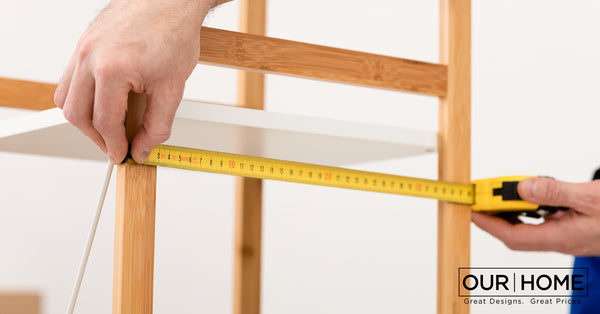The Guide to Measuring Your Space for Furniture
•Posted on April 24 2024

Are you thinking about getting some new furniture for your home? Before you go shopping, you need to consider one important thing: measure your space. In some ways, it can be a tedious task but it will make a huge difference!
Imagine finding the perfect sofa and dining table online. They may look amazing in the pictures but if they're way too large for your living room, your supposedly cozy space will feel crowded and awkward. This is why measuring your space is an important step in buying furniture.
In this guide, Our Home will walk you through the process of measuring your home space to help you create a home that perfectly aligns with your needs and preferences.

How to Measure Your Room Size
Step 1: Measure doorways and pathways
Before you bring in your new furniture pieces, it's a smart move to measure first the doorways and pathways they'll need to navigate. Grab your tape measure and get the height and width of the door. Don't forget to measure the space from the door itself to the wall inside the room to avoid any tight squeezes.
Measure the diagonal distance from one top corner of the doorway to the opposite bottom corner. This helps you anticipate if bulky furniture needs to be tilted when moving it through tight hallways or doorways, especially on staircases. Make sure that there is at least 10 cm of clearance between your furniture and the walls or door frame to save you stress (and maybe a bumped wall) when moving things around.
Step 2: Measure the area inside the room
Next, we need a map of your room. Stand at one wall and extend the tape measure to the opposite wall to get the length and width. To get the ceiling height, extend your tape measure straight up from the floor to the ceiling.
Having these dimensions will be your key to creating the perfect furniture layout, ensuring everything fits comfortably and avoids feeling cramped.
Step 3: Draw a floor plan
Here’s a pro tip for you: sketch out a simple floor plan of your room. Include the dimensions you just measured and mark the locations of doors and windows. This will give you a visual reference when placing furniture.

How to Measure Furniture Dimensions
Now that you have your room's measurements and a floor plan, it's time to ensure the furniture you love will fit perfectly. Here’s how you can get the furniture measurements correct:
1. Sofas
Here's how to measure a sofa: start by finding the width, which is typically the distance between the outer edges of the armrests. Next, extend the tape measure straight up from the floor to the highest point of the sofa to get the height. Finally, measure the depth from the front edge of the seat cushion to the back of the sofa.
While sofa sizes can vary depending on style, the standard sofa size typically measures around 229 cm wide in the seating area, 97 cm deep, and 86 cm high. You can use this as a reference but remember to always check the sofa specifications for the exact dimensions to ensure a smooth transition into your living space.
2. Tables
Knowing your table's shape beforehand makes measuring much easier. For a rectangular table, measure the longest side for the length and the shorter side for the width. Standard rectangular dining tables typically range from 90 to 100 cm wide and can be as long as 198 cm depending on how many people it seats.
Round or oval tables require measuring the diameter, which is the distance across the widest part of the table. Standard round tables typically range from 90 to 137 cm in diameter, again depending on seating capacity.
Don't forget to measure the table height as well. Standard dining table heights are around 70 to 76 cm, while counter and bar height tables can be taller.
3. Cabinets
To ensure the cabinet fits and meets your storage needs, measure its width, depth, and height, including any handles or knobs that might protrude and affect the available space. Consider the style you want—tall and narrow for small spaces, wide and low for larger areas, and choose a cabinet with dimensions that complement both your needs and the available space in your living room or bedroom.
4. Bedroom Furniture
To guarantee a proper fit and comfort, measure the width, length, and height of your bed frame, including the height from the floor to the top of the mattress. When buying additional bedroom furniture, like dressers or nightstands, accurately measure their width, depth, and height as well. This ensures the furniture fits within the available space and provides sufficient storage to meet your needs.
Why Measuring Your Space Is Important
Taking the time to measure your space before buying furniture isn't just a chore—it's crucial for creating a home that's both comfortable and aesthetically pleasing. Getting the precise measurements ensures the furniture fits perfectly in your home, avoiding frustration and allowing for seamless integration of function and style.
It also empowers you to plan a balanced layout that optimizes flow, prevents overcrowding, and keeps clutter at bay, ultimately resulting in a more inviting and spacious feeling at home. Use these tips to know the right living room furniture size for your space.
Are you ready to transform your living spaces? Our Home offers a stunning collection of living room furniture, sofa furniture, and other stunning pieces artfully designed to elevate the aesthetics of your space. Shop at ourhome.ph or visit any of Our Home stores nationwide for more options. You may also get in touch with a personal shopper via Call to Deliver at 0917-8315260.
Creating your dream home can be daunting, so let us ease your burden with Our Home's Design Expert Advice. Consult with our experts today to get the right furniture size for your home.